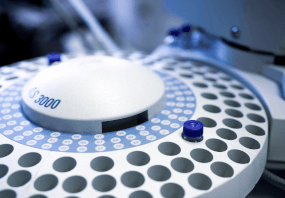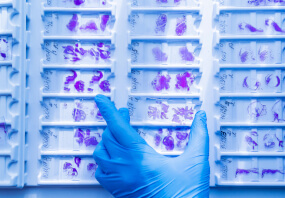General description
ColorWheel® technology is a novel and proprietary method of creating your own antibody and dye combinations for use in flow cytometry. By incubating any ColorWheel® antibody with any ColorWheel® dye, researchers can quickly and simply produce primary conjugated antibodies for use in single color or multicolor flow cytometry analysis. Each ColorWheel® antibody and dye is lyophilized for long-term storage, allowing for simplicity and flexibility without compromise. ColorWheel® technology requires both ColorWheel® antibody and ColorWheel® dye for Flow Cytometry application.
We are committed to bringing you greener alternative products, which adhere to one or more of The 12 Principles of Green Chemistry. This product is Preservative-free, lyophilized product for enhanced stability and allow for ambient shipping and thus aligns with "Waste Prevention", "Designing Safer Chemicals" and "Design for Energy Efficiency". Click here for more information.
Specificity
Clone UC10-4F10-11 is an Armenian hamster monoclonal antibody that detects CTLA-4 (CD152).
Immunogen
Mouse CTLA-4 IgG2a fusion protein.
Application
Quality Control Testing
Evaluated by Flow Cytometry in concanavalin A -stimulated BALB/c mouse splenocytes.
Flow Cytometry Analysis: One million BALB/c mouse splenocytes were stimulated with concanavalin A (3 µg/mL) for three days. Cells were fixed, permeabilized, and stained with APC conjugated anti-mouse CD4 clone RM4-5 and with 5 µL of a 1:1 mixture of Cat. No. CWA-1177, Anti-Mouse CD152/CTLA-4 (UC10-4F10-11) ColorWheel® Dye-Ready mAb and Cat. No. CWDS-PE ColorWheel® Antibody-Ready Phycoerythrin (PE) Dye or the equivalent amount of Cat. No. CWA-1014 Armenian Hamster IgG isotype control and Cat. No. CWDS-PE ColorWheel® Antibody-Ready Phycoerythrin (PE) Dye. CD4 expressing cells also express CD152/CTLA-4.
Tested Applications
Flow Cytometry Analysis: One million BALB/c mouse splenocytes were stimulated with 3 µg/mL of concanavalin A (ConA) for three days. Cells were fixed, permeabilized, and stained with PE conjugated anti-mouse CD4 clone RM4-5 and with 5 µL of a 1:1 mixture of Cat. No. CWA-1177, Anti-Mouse CTLA-4/CD152 (UC10-4F10-11) ColorWheel® Dye-Ready mAb and Cat. No. CWDS-APC ColorWheel® Antibody-Ready Allophycocyanin (APC) Dye or the equivalent amount of Cat. No. CWA-1011 Rat IgG1 isotype control and Cat. No. CWDS-APC ColorWheel® Antibody-Ready Allophycocyanin (APC) Dye. CD4 expressing cells also express CTLA-4/CD152.
Note: Actual optimal working dilutions must be determined by end user as specimens, and experimental conditions may vary with the end user
Compatibility
Requires ColorWheel® Dye (Sold Separately)
Target description
Cytotoxic T-lymphocyte protein 4 (UniProt: P09793; also known as Cytotoxic T-lymphocyte-associated antigen 4, CTLA-4, CD152) is encoded by the Ctla4 (also known as Cd152) gene (Gene ID: 12477) in murine species. CTLA-4 is a single-pass type I, disulfide-linked homodimeric, membrane glycoprotein that is synthesized with a signal peptide (aa 1-35), which is subsequently cleaved off to produce the mature protein that contains an extracellular domain (aa 36-161), a transmembrane domain (aa 162-182), and a cytoplasmic domain (aa 183-223). Its homodimerization domains are localized in amino acids 46-50 and 150-155. N-glycosylation of asparagine 108, 113, and 145 is essential for dimerization. CTLA-4 is widely expressed with highest expression observed in lymphoid tissues. Its expression is not observed in naïve CD+ or CD8+ T cells but is rapidly up-regulated and trafficked to the cell surface following TCR-mediated T-cell activation. It binds to two ligands, CD80 (B7-1) and CD86 (B7-2), which are shared with CD28. However, its affinity for CD80 and CD86 is significantly higher. Amino acids 134-139 are reported to be important for its interaction with CD80 and CD86. It serves as an inhibitory receptor acting as a major negative regulator of T-cell responses and controls peripheral tolerance and the development of autoimmunity. It interferes with the ability of T-cells to form stable conjugates with antigen-presenting cells (APCs). CTLA-4 plays a key role in restraining the adaptive immune response of T-cells towards a variety of antigens including tumor associated antigens. (Ref.: Brunner-Weinzierl, MC., and Rudd, CE (2018). Front. Immunol. 9; 2737; Mocellin, S., and Nitti, D. (2013). Biochim. Biophys. Acta. 1836(2):187-96).
Physical form
Lyophilized from PBS containing D-Mannitol and Sucrose, normal appearance is a dried pellet. Reconstituted antibody solution is stable and functional as assessed by functional testing. Contains no biocide or preservatives, such as azide.
Reconstitution
1.0 mg/mL after reconstitution at 25 µL in PBS. Please refer to guidance on suggested starting dilutions and/or titers per application and sample type.
Storage and Stability
Recommend storage of lyophilized product at 2-8°C. Before reconstitution, micro-centrifuge vials briefly to spin down material to bottom of the vial. Reconstitute each vial by adding 25 µL PBS. Protect from light.
Legal Information
ColorWheel is a registered trademark of Merck KGaA, Darmstadt, Germany
Disclaimer
Unless otherwise stated in our catalog or other company documentation accompanying the product(s), our products are intended for research use only and are not to be used for any other purpose, which includes but is not limited to, unauthorized commercial uses, in vitro diagnostic uses, ex vivo or in vivo therapeutic uses or any type of consumption or application to humans or animals.
- UPC:
- 51202410
- Condition:
- New
- Weight:
- 1.00 Ounces
- HazmatClass:
- No
- WeightUOM:
- LB
- MPN:
- CWA-1177-25UL
- Product Size:
- 1177-25UL












